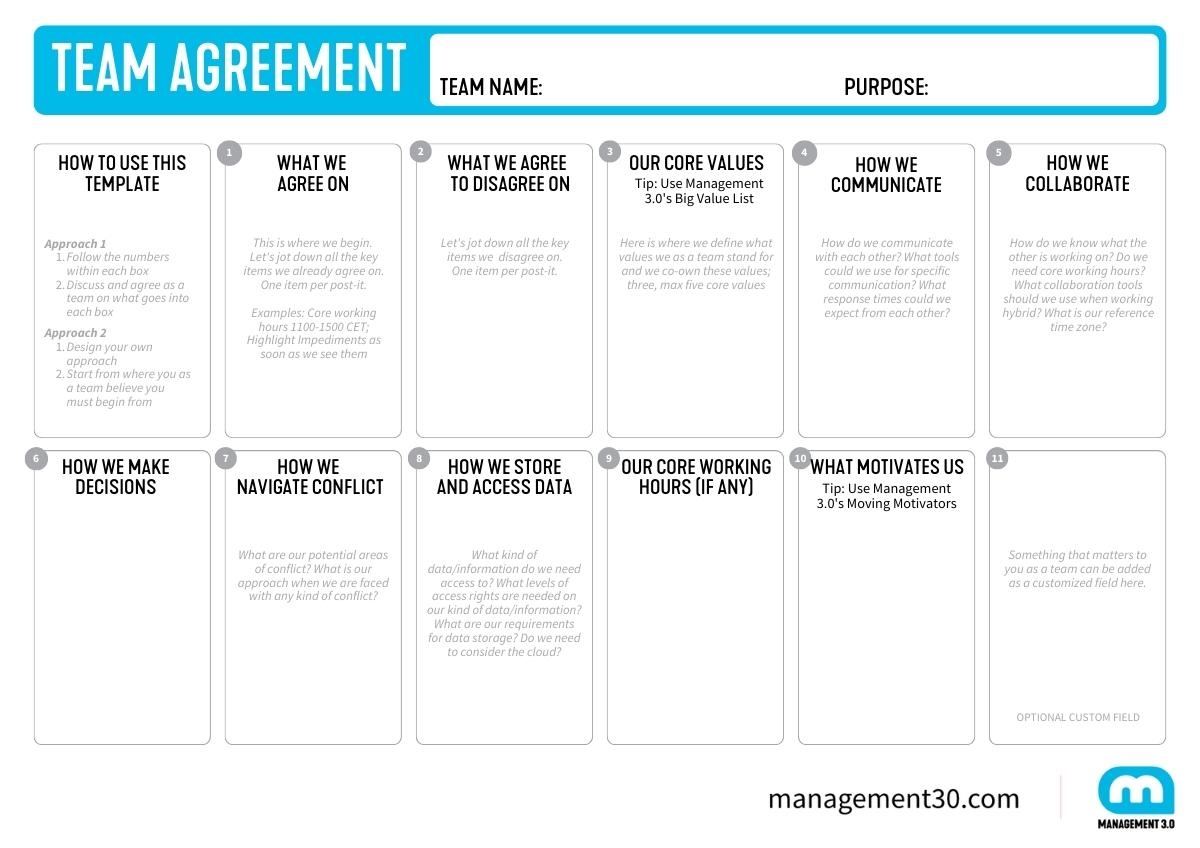
Tell us a bit about yourself, and we’ll tailor our recommendations to match your interests. Just answer a few quick questions below to get started!
Build upon the foundation of your knowledge by delving deeper into the main principles and practices of Agile Leadership with our Agile Change Leadership Workshop.
Build upon the foundation of your knowledge by delving deeper into the main principles and practices of Agile Leadership with our Agile Co-Creation Leadership Workshop.
Build upon the foundation of your knowledge by delving deeper into the main principles and practices of Agile Leadership with our Agile Team Leadership Workshop.
Build upon the foundation of your knowledge by delving deeper into the main principles and practices of Agile Leadership with our Agile People Leadership Workshop.
If you are interested in other options we offer, please check our Learning Path.
The Foundation Workshop is where your Management 3.0 learning journey truly begins, and you will learn about the principles, pillars and popular practices you can use right away.
The Foundation Workshop is where your Management 3.0 learning journey truly begins, and you will learn about the principles, pillars and popular practices you can use right away. If you are interested in other options we offer, please check our Learning Path.
Agility in HR Workshop by Management 3.0 is the popular Management 3.0 Foundation Workshop with additional content and ICAgile accreditation targeted for people who work in or closely with human resources.
The Foundation Workshop is where your Management 3.0 learning journey truly begins, and you will learn about the principles, pillars and popular practices you can use right away.
With our global team, we provide tailor-made programs to enhance mindsets and skills for entire organizations, ensuring your business is future-ready! Learn more about our Inhouse Training Programs.
Our Company License gives your learning team, transformation staff and leaders the ability to facilitate the Management 3.0 mindset, practices and official workshops yourselves.
You sound like a match for our global Facilitator community! Get your Management 3.0 Facilitator License now!
We have defined certain requirements that you must meet to become a licensed Management 3.0 Facilitator. We offer both workshop-based and practice-based approaches. Read more about the requirements.
In the Official Management 3.0 Community you can connect with curious and focused like-minded leaders from all over the world to practice, share, and grow!
Our practical, hands on and tangible tools and management games are the best way to foster transformational change within teams, companies and even on a personal level.
What is a team agreement? Why is it important? And how do we create a good one? Sarika Kharbanda, Management 3.0 Facilitator from India, has guided several agile teams through the team agreement creation process and shares her experience.
We are all human. This means we have different preferences, expectations, communication tools, and different opinions. There’s bound to be disagreement!
During one of my many journeys of onboarding teams to a hybrid way of working, I gathered perspectives from the teams and managers.
| Team Perspective Issues | Manager Perspective Issues |
|---|---|
| I work from an area with such poor network coverage. How can I be expected to keep my video on? | His video is always switched off. I have no idea what you are doing. |
| I didn’t work on that task as I had no access to the data! | Team members just grab any task without even informing. |
| If you had told me this was urgent, I would have responded in 1 hour instead of a day! | I’d asked for her feedback about an issue over email. They don’t check email! They can’t expect me to write that again on Slack! |
| Oh! I didn’t know there were core working hours for our team! | Not everyone is reachable during the core working hours! |
| I wasn’t aware whether you were in the office. How could I be expected to keep track of your timezones? | I wasn’t aware whether you were in the office. How could I be expected to keep track of your timezones? |
These issues came as no surprise to me. There’s bound to be misalignment – until we do something about it.
The traditional approach:
What happens when such an approach is pushed down the throats of people? For some, it goes well. For many, they get labeled as rule breakers who impede the success of the team.
My approach:
This includes the modern approach to management, whereby a new way of working has to be co-created in the true sense of the word ‘co-creation.’
If we can create an environment where people are invited to contribute and share their perspectives on the issue or problem at hand, they feel they have added value. They feel they have been listened to. When we use their input to co-design the solution for the issue, they feel their inputs mattered and that they’ve added value. They are less likely to resist and more likely to co-own the solution. Isn’t that what we want in the first place?
Why impose a solution when you could get them to co-create it with you and co-own it with you?
How do I co-create?
I work with each team and their respective manager. Each team member, each team, and each manager is unique in their personality, perspectives, and work preferences.
I invest the time to introduce the concept of ‘team agreement’ to everyone.
For me, a good team agreement has always been:
Of the many benefits of creating team agreements, here are a few highlights:

Teams soon realize it’s not easy to co-create a team agreement. We are working with people and not robots!
So, it’s best to start with what they know they all agree on.
For one of the teams, agreeing to the core working hours was easy. So, they started with that.
Another team agreed that they did not know each other well enough. So, they would like to start by getting to know each other first. I got them started with the Management 3.0 practice of Personal Maps. With this activity, when they understood Values were crucial for all, they wanted to co-create what their values as a team were.
Another team was beginning from a state of conflict. So, they agreed they would start by enabling resolution to the conflicts that had arisen. I introduced the 360 Degree Feedback Dinner to them. They liked the idea and experimented with that for a few weeks. They even created a separate section within the team agreement for how they would acknowledge and resolve conflicts as a team.
Looking at what some teams had started to radiate visually, other teams got inspired and started to get their manager and team together to create what they called their ‘Team Manifesto’. Each team member signed it and presented it to other teams during the department town hall. They felt so proud of that achievement!

You may want to use this team agreement template:


I facilitated a common retrospective across all teams. This is some of what they had to say.
“The team agreement really gave us a bumper start. We stopped making assumptions, finally got to surface and acknowledge, and finally take action on them.”
“We are not completely where we want to be. But, we are happy that we are continuously improving our way of working each day. We have come a long way. We strive to get there together.”
“Us and our manager were completely misaligned on how we work. Simple things caused misunderstanding like when he thought we were slacking off with our videos off, we just had bad network coverage. Surfacing these points and together building trust and actions has helped rebuild our relationship.”
“We’ve all had a different starting point before we got to creating the team agreement. We thought we would just be asked to follow and stick to some template. But the fact is that no two team agreements are alike in any way or form. That this was OK and a done thing! That itself is so cool!”
“Each of our voices mattered. We were all involved in coming up with how we collaborate, how we communicate, where information is stored, how we would resolve conflicts, how we would raise issues, make decisions, etc. It feels great to be part of something WE actually created and then followed with our own will, not something that was forced upon us.”